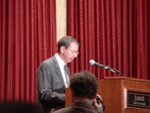Frequent visitors to oklo.org will have noticed a definite fall-off in the number of recent posts. This was a direct result of the start of the winter quarter here at UCSC, but now things are rolling, and the systemic team is working hard to prepare the next phase of the collaboration.
Last week was also the 207th meeting of the American Astronomical Association. I took a one-day trip to Washington in order to give a talk at Tuesday’s extrasolar planets session entitled, “From Hot Jupiters to Hot Earths“. I teach class on both Monday and Wednesday mornings, so the trip was more of a lightning raid.

I arrived at Dulles Airport at 6 am, after an overnight flight. My talk wasn’t finished, so I sat in an empty departure lounge for several hours and worked on the slides. By mid-morning, I realized that I had better head to the venue. I took a cab to the conference hotel, tapping on the laptop for most of the way.
Hundreds of astronomers were thronging in the hallways. I studied the posters that had been set up in a large exhibition hall, and then went to hear NASA Administrator Griffin give a keynote address, the gist of which was clearer than this snapshot (taken under low-light conditions).

Two of the things he said stuck in my mind.
Like it or not, NASA has been charged to fly to the moon for reasons that are completely divorced from astronomy, and this means that there will be opportunities to use a lunar platform for observations of extrasolar planets. Transit photometry of nearby stars, especially M-type stars, jumped to mind, but clearly, there is a serious opportunity right now to start thinking outside the box.
He also said that the primary education and outreach mission of NASA should be to inspire by doing “cool things”. I do remember watching the last Saturn V’s blast off for a lunar destination, and I remember, a few years later, learning in grade school science class, about the Space Shuttle, that “pickup truck into orbit”, and feeling distinctly less inspired. In the intervening years, my list of the coolest NASA things runs along the lines of, Voyager, HST, WMAP, Cassini-Huygens, and Spitzer. And there’s also the BPP project. (For more detail on interstellar missions, Paul Gilster’s Centauri Dreams is always the place to go).
Uh, my talk wasn’t all it could have been. In order to facilitate rapid transitions between the session speakers, everyone’s slides were uploaded to a central server. The server was running Windows, and all the Powerpoint presentations looked exactly like they were supposed to. Full screen ahead. As a Keynote user, however, my slides were in the form of .pdfs. They looked just fine in the speaker ready room, but then, when I stepped up to the podium, I was aghast to see that my .pdfs were displaying on only on a small portion of a screen containing an acrobat viewer, complete with a sneak “preview” and a sneak “review” of the next and previous slides. The resolution was too low to see any detail. Score one for Mr. Bill Gates.
For the record, though, here are the slides (full resolution .pdfs).
